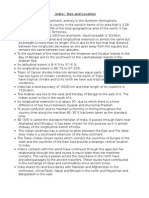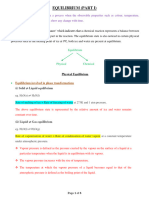0% found this document useful (0 votes)
84 views2 pagesChapter 1
Chapter 1 discusses India's geographical size and location, highlighting its latitudinal and longitudinal extensions, which affect climate and time zones. India experiences a tropical climate in the south and a sub-tropical climate in the north, with a standard meridian of 82°30' East for uniform time. The chapter also notes India's central position in the Indian Ocean, facilitating trade with various regions.
Uploaded by
Arpan SenCopyright
© © All Rights Reserved
We take content rights seriously. If you suspect this is your content, claim it here.
Available Formats
Download as PDF, TXT or read online on Scribd
0% found this document useful (0 votes)
84 views2 pagesChapter 1
Chapter 1 discusses India's geographical size and location, highlighting its latitudinal and longitudinal extensions, which affect climate and time zones. India experiences a tropical climate in the south and a sub-tropical climate in the north, with a standard meridian of 82°30' East for uniform time. The chapter also notes India's central position in the Indian Ocean, facilitating trade with various regions.
Uploaded by
Arpan SenCopyright
© © All Rights Reserved
We take content rights seriously. If you suspect this is your content, claim it here.
Available Formats
Download as PDF, TXT or read online on Scribd
/ 2


















































































